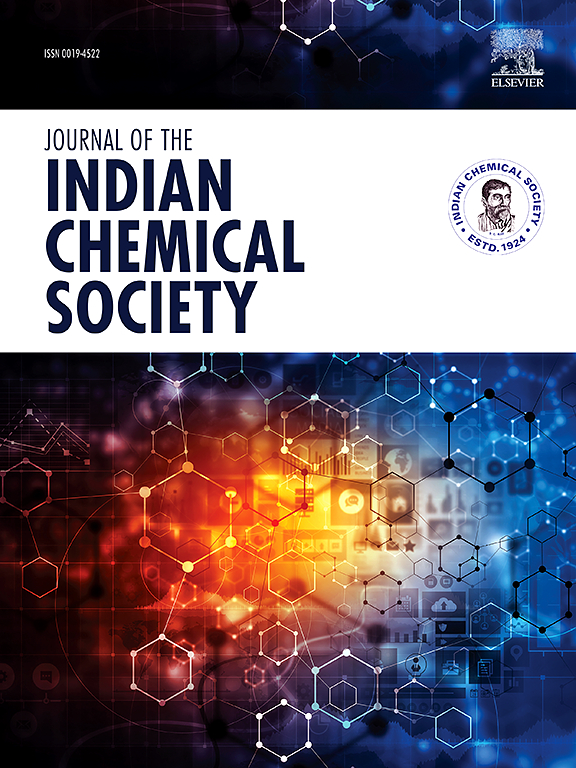Lithium ion conducting Cardiospermum halicacabum bio-electrolytes for electric double layer capacitor and lithium ion conducting cell applications
IF 3.2
4区 化学
Q2 CHEMISTRY, MULTIDISCIPLINARY
引用次数: 0
Abstract
Cardiospermum halicacabum (C.halicacabum), commonly known as balloon vine, a medicinal herb is investigated as a electrolytic material for all solid state batteries and supercapacitor applications in this research. C.halicacabum – lithium nitrate (LiNO3), a new bio-electrolyte system is developed by adopting a solution casting technique, and the effect of LiNO3 of varied amount (0.6 wt % to 1.0 wt %) on the electrolytic system is analyzed. The mandatory requisite of amorphous phase in electrolyte is ensured with an X-ray diffraction study and the interaction between host and salt material is explored by means of Fourier -Transform infrared (FTIR) study. Electrochemical impedance analysis (EIS) detects the diminishing resistive behavior with increasing amount of salt in the host material of C.halicacabum and the highest ionic conductivity value achieved is 7.02 × 10−3 S cm−1 with the addition of 0.9 wt% of LiNO3 with the host material. Electric double layer capacitor (EDLC) is constructed with the best conducting membrane as electrolyte. The Cyclic voltammetry (CV) results show the maximum specific capacitance of 166.67 F/g and the Galvanostatic charge –discharge (GCD) study shows the assembled EDLC is able to offer a high power density of 6250 WKg-1 at a current density of 50 mA/g. Also, GCD ensures the cyclic stability of the synthesized membrane. Additionally, lithium ion conducting cell is fabricated with the best conducting membrane and the output of 1.7 V is obtained with a good stability. All these results recommend the chosen biomaterial is a potential candidate in energy storage applications.

锂离子导电双电层电容器及锂离子导电电池用心菜生物电解质
本研究探讨了一种俗称球囊藤的中草药——心药(Cardiospermum halicacabum)作为所有固态电池和超级电容器的电解材料的应用。采用溶液铸造技术研制了一种新型生物电解质体系——硝酸锂(LiNO3),并分析了不同浓度(0.6 wt % ~ 1.0 wt %)的LiNO3对电解质体系的影响。通过x射线衍射研究确定了电解质中非晶相的必要条件,并通过傅里叶变换红外(FTIR)研究探讨了基质与盐物质之间的相互作用。电化学阻抗分析(EIS)发现,随着盐的添加量的增加,盐的电阻行为逐渐降低,当LiNO3添加量为0.9 wt%时,盐的离子电导率最高,为7.02 × 10−3 S cm−1。双电层电容器(EDLC)是以导电性能最好的薄膜作为电解液制备而成。循环伏安(CV)测试结果表明,该材料的最大比电容为166.67 F/g,恒流充放电(GCD)测试结果表明,该材料在50 mA/g电流密度下的功率密度可达6250 WKg-1。同时,GCD保证了合成膜的循环稳定性。采用最佳导电膜制备了锂离子导电电池,输出电压为1.7 V,稳定性良好。所有这些结果都表明所选择的生物材料是储能应用的潜在候选材料。
本文章由计算机程序翻译,如有差异,请以英文原文为准。
求助全文
约1分钟内获得全文
求助全文
来源期刊
CiteScore
3.50
自引率
7.70%
发文量
492
审稿时长
3-8 weeks
期刊介绍:
The Journal of the Indian Chemical Society publishes original, fundamental, theorical, experimental research work of highest quality in all areas of chemistry, biochemistry, medicinal chemistry, electrochemistry, agrochemistry, chemical engineering and technology, food chemistry, environmental chemistry, etc.

 求助内容:
求助内容: 应助结果提醒方式:
应助结果提醒方式:


